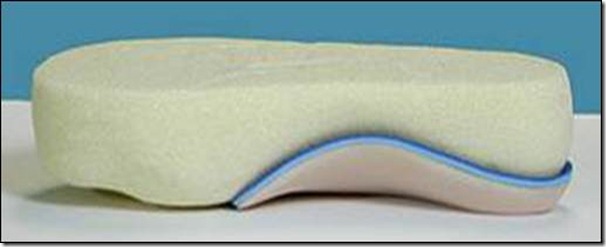Custom Foot Orthotics: Are they really Custom?
 Tuesday, April 13, 2010 at 8:47AM
Tuesday, April 13, 2010 at 8:47AM Stuart Currie DC,
Director of Research, Sole Supports.
When is a custom foot orthotic not a custom foot orthotic? Practitioners prescribing these devices need to know. The word “custom” is often used in the foot orthotic industry and critical thought as to its meaning is warranted for the astute practitioner. We are bombarded in both the public and professional domains with advertisements and claims for the “Custom Foot Orthotic”. As the American physicist and Nobel Prize winner Richard Feynman once said, “For a successful technology, reality must take precedence over public relations, for nature cannot be fooled.”
There are two main considerations when determining the level of custom that an orthotic provides: (1) How it is casted, and (2) how that cast is manufactured. What will become clear very quickly is that the notion of “custom” is not entirely black or white, but a scale ranging from completely prefabricated devices, to “best fit” devices pulled from a library of molds or feet, to truly custom devices based on a model of the foot in a corrected position.
To start, let us review a description of the casting process for a custom-made orthotic:“The cast is taken in a position that minimizes mechanical anomalies by either improving foot alignment or accommodating foot alignment when necessary. A three dimensional mold of the foot is necessary in order to fabricate a truly custom-made orthotic”.1Any provider dispensing a custom foot orthotic, therefore, must know how they intend to influence the foot’s alignment (or posture). The biomechanical goals and how they can be achieved through a cast of the foot are crucial to a custom prescription and have been outlined in a previous AJCC article.2 In order to attain a corrected position with an orthotic device it must be achieved in the cast and then communicated to the lab. A cast that is taken in full weight-bearing therefore, would have to be altered by the lab in some way to achieve correction of any mechanical abnormalities. Because this is performed using assumptions, this type of alteration lessens the custom properties of the doctor’s prescription.
Any discussion of casting as it relates to a custom orthotic needs to address the issue of digital casting and manufacturing methods. There exists significant confusion as to the efficacy of the digital methods used today. A digital impression of the foot may have utility in conjunction with a proper physical assessment in at- risk populations such as diabetics and those diagnosed with rheumatoid arthritis.3 However, two dimensional data alone cannot provide exact information for the third dimension in order to manufacture a custom-made foot orthotic. So while there is no inherent flaw in the digital technology itself, it is incapable of providing the data needed for a custom-made orthotic. From the Pedorthic Association of Canada on casting technique: “Casting does not include taking an imprint on an ink pad or forceplate”1.
Accurate vertical dimensions of a foot cannot be predicted from footprints or measurements of the plantar surface area. In one study only 27% of the vertical arch height could be estimated by plantar surface data4, so using this data alone would negate roughly three-quarters of the clinical picture. This is not a confidence level most would be comfortable with for the manufacture of a custom device. I have heard the analogy worded this way: Estimating arch height from plantar pressure data is akin to trying to draw the skyline of a city using only the weights of the buildings.
FIGURE 1. True custom-made foot orthotics are fabricated from a 3D volumetric model of the patient’s foot that duplicates its unique plantar anatomy in a corrected position, to which raw materials are molded to create the orthotic.
The Prescription Foot Orthotic Laboratory Association (PFOLA) differentiates between two types of orthotic manufacture. Those that use anatomical models and those which use extrapolated models. This second type of model is a digital model that “approximates” a person’s anatomy using mathematical models to extrapolate pressure, temperature or light data.5 A third type of manufacturing with an even less custom process uses a library of pre-made orthotic shells choosing a “best fit” approach to the cast in question; sometimes the criteria can be as vague as foot length or size.
The above information helps us draw a distinction between “customized” and “custom-made”. A customized orthotic uses an extrapolated model or a library of shells in the manufacturing process, while a custom-made orthotic uses anatomical three-dimensional data from the patient’s foot.
When trying to determine if your orthotic company makes custom-made or customized orthotics, ask yourself this question: How does the lab determine the three dimensional height of the corrected arch? If you are not providing it in your cast then there must be a lab extrapolation. Other variables that increase the custom properties of an orthotic include the patient’s weight, the patient’s foot flexibility, and the patient’s activity levels.
There is no secret to the process of manufacturing a truly custom-made device. Your lab should be forthcoming with any and all information concerning the manufacture of the devices you prescribe. As a doctor it is your responsibility to provide the most custom orthotic to your patients, after all, the diagnosis and treatment of patients is a custom business.
Reference List
(1) Pedorthic Assoc. of Canada. www.pedorthics.ca. Internet Comm.
(2) Currie S.J. AJCC 2009;19(4):4,26.
(3) Randolph AL, Arch Phys Med Rehabil 2000 May;81(5):573-8.
(4) McPoil T. J Am Podiatr Med Assoc 2006;96(6):489-94.
(5) PFOLA. www.pfola.org. Internet Comm.
 CBP Seminars | Comments Off |
CBP Seminars | Comments Off | 



